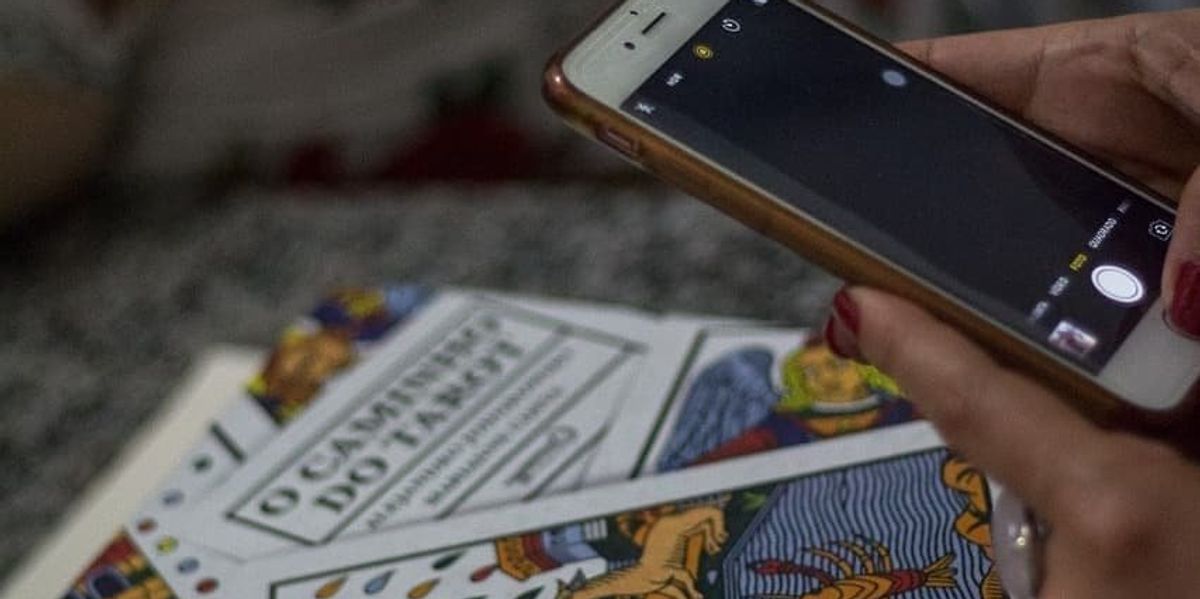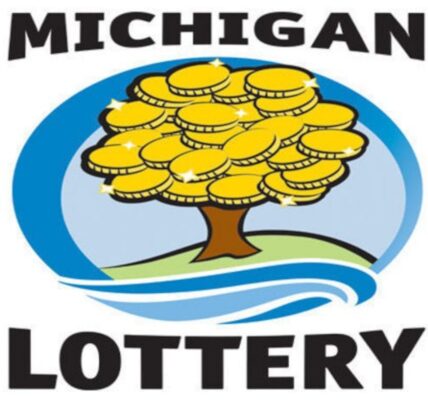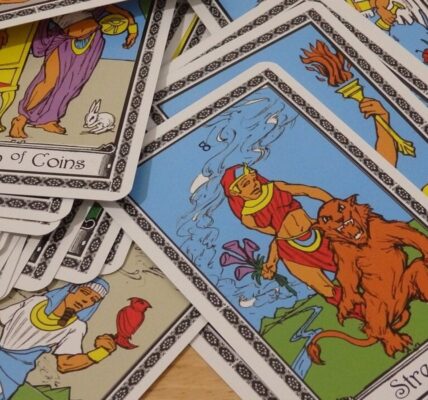
In 1930, the surrealist painter Leonara Carrington came very close to synthesizing the symbolism of tarot cards, which date back at least several hundred years and are often used to divine the future: “Each arcana, being a mirror and not a truth in itself, becomes what you see. The tarot is a chameleon,” said the artist, noting that the cards, even if they have the same meaning, can represent different questions for each one who consults them. The tarot, therefore, can be a direct and intimate channel for those who play them, or a kind of mirror in which the client’s truths are reflected.
Leonora’s theory rings true with many tarologists or scholars who study this art: a game that contains 22 major and 56 minor arcana (or cards). For many, the game is a key to unravel intimate issues or to help choose paths in difficult or pleasurable moments.
Sabrina Carvalho, a tarot reader from Pernambuco, Brazil, began studying the subject in 2007. She describes it as a “chameleon.” The cards are “a great tool for self-knowledge and connection, a tool for communicating with ourselves,” says Sabrina, who has worked as a tarot reader since 2012, and who is responsible for the creation of the Carcará tarot school, which has trained hundreds of people to read cards in Pernambuco.
A window to the unknown
Sabrina, in fact, is one of the many professionals who have realized, over time, the connection between the tarot and the unconscious. This thesis has been defended more than a century ago by the analyst Carl Gustav Jung, who argued that, from the figures stamped on the cards, people can reflect on the virtues and disappointments of their own existence, and make decisions more favourable to their own development.
You give the unconscious a vehicle to express itself.
But what magic could lead to the choice of the right card? For Jung, everything is the result of psychic movement. When you choose a certain number of cards at random from a pile, you give the unconscious a vehicle to express itself. This one will then use, from the symbols of the cards, a channel of communication with the conscience, and bring answers to make sense of the present moment.
Tarot and card reading
Based on this tarot-person dialogue, Sabrina believes that the search for self-knowledge is the most profound and appropriate way to use the game. She advises against card reading consultations, which she herself does not practice.
The choice will always be up to the person.
Ronaldo Silva, who studies tarot and works with Sabrina, agrees: “As the consultant opens up, the tarot dialogues with him, opening doors, showing the most appropriate paths. But (the tarot) does not determine; the choice will always be up to the person,” says Ronaldo, who has strong restrictions on the use of cards to try to peer into the future, or cartomancy.
“I think cartomancy is an abusive practice because the person can say whatever they feel like, and impact those who are seeking help. In addition, it is a passive practice, as the consultant is exempt from responsibility for his own life; he only expects finalized answers,” he says.
The Brazilian tarologist Veet Pradama, in the book Tarot Course and its Therapeutic Use, also dismisses trying to read the future: “If we insist on showing our consultants that their lives are the product of strange and unpredictable forces such as luck, bad luck, divine will … we are degrading human beings to the category of slaves that they can never free themselves,” he wrote.
Caracara
In the 1980s and 1990s, the tarologist Helena Rego became prominent in the local Brazilian scene, with courses given at the now-closed Livraria Síntese, which operated on Rua do Riachuelo, in the center of Recife city and brought together those in love with cards. The tarot, at the time, attracted curiosity, but it was still an unknown and little-known subject among Recife residents.
From the second decade of the 21st century, the scene has changed. With Sabrina Carvalho’s establishment in the area and the opening of the Carcará school in 2019, the scene experienced a boom, with the formation of several new tarologists. Classes were given in Maumau gallery, in Espinheiro neighbourhood, and not only attracted new students but also new ideas that mixed tarot and art.
It was there that, in 2019, the artist Maurício Costa suggested the creation of the first tarot from Pernambuco. With the support of Sabrina and 25 other artists, a deck – now sold out – made in engraving, and all in black and white, was released.
“Only 50 tarots were made, and they were sold quickly,” recalls Sabrina, who soon after the launch had to face the COVID-19 pandemic. Like the entire planet, Sabrina was forced to reinvent herself. Online consultations became a routine, which continues to this day, alongside face-to-face consultations. Some courses are also offered online and in person. Recently, the tarot reader promoted a tarot and yoga workshop and a small seminar on tarot and love. Her Instagram profile – where she maintains a weekly game system for followers – has become essential for connecting with the public.
I think tarot is in a good moment. It became a trend.
In addition, she is part of the group Tarological Coffee, composed by also tarologists Rebeca Oliveira, Aristeu Portela and Ronaldo Silva, and partners in studies and public events. “I think tarot is in a good moment. It became a trend,” says Sabrina, who, however, does not fail to recognize that there is still prejudice and a lack of knowledge about the cards. Many fear that the tarot is a bearer of bad news. “Our work to demystify this issue is very important,” she says.
The tarologist Aristeu Portela, who started working in the field in 2018, also believes that tarot has been establishing itself. “If we were to evaluate the popularity of profiles dedicated to tarot on social networks, I would certainly say that it has been increasing in recent years in various parts of Brazil,” Portela says. As an example, he points to Saturnalia, an astrology school that also offers online tarot courses and which is very popular.
Thousands of tarot decks
For the uninitiated, an important note: only decks containing 78 cards are considered tarot, with the 22 major arcana and the 56 minor arcana, divided into four suits: sword, hearts, clubs and gold, which each contain 14 cards, and which, according to specialists, represent the material and physical issues of the consultant.
There are thousands of decks. The most used in Latin countries is the Marseille tarot, a classic with far-fetched symbology, inspired by Milanese decks; it would have originated in Italy before migrating to France, where it became popular around the world.
Other decks, in turn, are true pieces of art, like the Salvador Dali tarot, which features him and his wife Gala as characters in some cards, or the one of Gustav Klimt, which uses the painter’s pictures to illustrate the arcana. The Art Nouveau deck features figures who follow the elaborate pattern of the artistic school. But they, despite being used for games, are better known as collector’s items, due to the beauty and finishing of the editions.
Some, specifically, are a curiosity, like the one with only cats representing the arcana. Or the ones that shows witches. And one of them is unbelievable: signed by the Italian comic artist Milo Manara, this tarot brings all the sexual explosion that the artist’s stories portray. Sex and obscene close-ups set the tone of the cards.
Even though it is not her favourite tarot, Sabrina says that this one can be good for anyone who wants to consult sexual issues. Anyone who visits her workshop is faced with at least a few dozen dazzling tarots. “I like and play with all of them,” she says.
Despite the statement, it is possible to notice that among the many “favourite” decks, one is much more handled and worn than the others: the Smith-Waite tarot, released in 1910 by the English occultist Arthur Waite and by the English artist Pamela Colman Smith, which brings a different symbology from the versions of the Marseille tarots and their occult derivatives, and which today is one of the most used in English-speaking countries.
The controversy surrounding this deck, which has earned millions of dollars over the last century, stems from the following reason: Colman Smith was as well versed in the occult as Waite. She also participated in the Hermetic Order of the Golden Dawn (Golden Dawn), a school dedicated to tarot, kabbalah, mysticism and hermeticism. The artist, therefore, had a vital influence on changing the archetypes and the design of the cards. But she died in poverty, without enjoying the potential of her most important work. Today, decades after her death, her name has been reincorporated into the tarot.
“In tarot games, the presence of masculine and feminine energies is essential.”
For Aristeu Portela, Smith-Waite is also his favourite. And the first one he acquired. He uses it mainly when he makes queries for other people. When he plays for himself, he also uses the Queer Tarot, by Ashley Molejo and Chess Needham. “It charms me with its queer and subversive reinterpretation of classic Pamela images,” he says.
But the Smith-Waite tarot is just one option. Each tarologist has their own personal preference. Ronaldo Silva chose the traditional one from Marseille and a rare tarot, now only found in used bookstores, the Encantado. In the case of the latter, the choice was made for a special reason: it was with these cards that the tarologist began in the 1990s, when he began his studies in the area. “There is a whole dialogue with the tarot and with the archetypes it suggests. I’m conservative,” says Ronaldo.
In addition to the Marseille and Smith-White decks, a third one is on the list of the most used, famous and controversial: the Thoth tarot, by Crowley Harris, made in partnership with Lady Freida Harris.
Crowley wrote the called Book of Thoth, which became a hit with occultists and scholars who like the metaphysics behind the cards. He was a poet, magician, writer, hedonist and occultist whose main motto was “Do what thou wilt shall be the whole of the Law.”
Crowley’s tarot, which is still shrouded in controversy due to its transgressive potential, was only published after he and Lady Freida died in 1969. In Sabrina Carvalho’s opinion, it is one of the most feminist tarots, as it does not have kings among the arcana, only princesses and queens.
Like Pamela and Waite, Crowley was also a member of the Hermetic Order of the Golden Dawn, whose influence on 20th century tarots cannot be underestimated.
Recently, a Brazilian tarot, signed by Elisa Riemer and Paula Maria, the We, launched in 2018, has been enchanting generations of tarologists. Bringing only female arcana, which replace the traditional male ones, the tarot portrays black, Indian, oriental women and impresses with its visual beauty and recreated archetypes.
Sabrina Carvalho, for example, uses it exclusively to play with female clients. But despite her admiration for her work, she ponders. “She is fantastic, and shows an empowerment rarely seen. But I admit that in tarot games, the presence of masculine and feminine energies is essential.”
Tarot origins
The origins of tarot are the most contentious and controversial subject surrounding the deck. The most accepted theory is that, around the 15th century, an artist named Bonifácio Bembo painted a set of letters without names and numbers for the Visconti family of Milan.
These images, as recorded by tarologist and scholar Rachel Pollack in her classic Seventy-Eight Degrees of Wisdom, included the classic deck, used in an Italian game called tarot: four sequences of 14 cards plus 22 arcana showing different scenes and later called Triumphs.
“Currently, many of these 22 cards, the arcana, can be interpreted as a simple catalog of medieval social types, such as the Pope or the Emperor, or moral concepts common in the Middle Ages, such as the Wheel of Fortune. There is even a letter representing a popular heresy, an image of a Popess that can be described as a mockery of the Church,” describes Rachel. This version would have given rise to other tarots, she says.
But she asks herself: do the 22 archangels correspond to the 22 Hebrew letters? “A brief look at the striking correspondences between the tarot and the body of Jewish mysticism and occult lore, collectively called the Kabbalah, will demonstrate the way in which Bembo’s cards seem almost to demand an esoteric interpretation, despite the lack of hard evidence.”
Is the tarot an invention of the extinct mythical Atlantis civilization?
If tarot originated in Italy, how can one explain the fame of the Marseille deck? “When the French conquered Milan and the Piedmont region in 1499, they took the game of triumphs to the south of France. Tarot became popular in the city of Marseille, which became a major center for card reproduction in Europe,” notes the Complete Book of Tarot.
Others claim that tarot originated in Ancient Egypt, based on reports that in the library of Alexandria there was a deck of tarot sheets forged in gold, and papyri that explained its meanings. But with the library burning down, there’s no way to be sure.
However, the most fantastic origin attributed to the tarot is given by the tarologist, kabbalist, numerologist and professor Nilton Shutz. According to him, the tarot is an invention of the extinct mythical Atlantis civilization.
To explain this thesis, Nilton says that the lost continent had seven cities, plus a central nucleus inhabited by angels and gods. Using numerology, he multiplies the seven cities by the number 3, which makes 21, and adds the eighth holy city, which makes 22, the sum of the major arcana.
With the fall and flood of Atlantis, the Egyptians, who would be part of that civilization, would have become the keepers of the tarot. The Hebrews, who would also be there, would be other protectors, so the Hebrew alphabet would have 22 letters. And the Roma, who are nomadic to this day, were tasked with helping to spread it around the world. True or not, no one will ever know.
From Your Site Articles
Related Articles Around the Web




